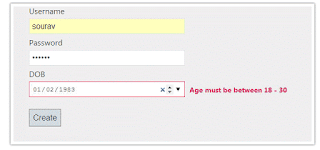Introduction
In this post, How to implement Custom user defined Age Range Validation / Data Annotations rules in MVC 4 application.There are many validation attributes available in MVC 4 like required, StringLength, Range, RegularExpression and more but sometimes we may require specific type of validation. In this article, I will explain how you can create your own custom validation attribute for validation Age Range and also how to make it work on client side as well.
Steps :
Step - 1 : Create New Project.
Go to File > New > Project > Select asp.net MVC4 web application > Entry Application Name > Click OK > Select Internet Application > Select view engine Razor > OKStep-2: Add a Database.
Go to Solution Explorer > Right Click on App_Data folder > Add > New item > Select SQL Server Database Under Data > Enter Database name > Add.Step-3: Create table for save data.
Open Database > Right Click on Table > Add New Table > Add Columns > Save > Enter table name > Ok.In this example, I have used one tables as below
Step-4: Add Entity Data Model.
Go to Solution Explorer > Right Click on Project name form Solution Explorer > Add > New item > Select ADO.net Entity Data Model under data > Enter model name > Add.A popup window will come (Entity Data Model Wizard) > Select Generate from database > Next >
Chose your data connection > select your database > next > Select tables > enter Model Namespace > Finish.
Step-5: Add a new class for create custom validation rule.
write the following code in this class.We need to import following namespace
using System.ComponentModel.DataAnnotations;
using System.Web.Mvc;
public class AgeRangeValidation : ValidationAttribute, IClientValidatable
{
public int MinAge { get; set; }
public int MaxAge { get; set; }
protected override ValidationResult IsValid(object value, ValidationContext validationContext)
{
//THIS IS FOR SERVER SIDE VALIDATION
// if value not supplied then no error return
if (value == null)
{
return null;
}
int age = 0;
age = DateTime.Now.Year - Convert.ToDateTime(value).Year;
if (age >= MinAge && age <= MaxAge)
{
return null; // Validation success
}
else
{
return new ValidationResult(FormatErrorMessage(validationContext.DisplayName));
// error
}
}
public IEnumerable<ModelClientValidationRule> GetClientValidationRules(ModelMetadata metadata, ControllerContext context)
{
//THIS IS FOR SET VALIDATION RULES CLIENT SIDE
var rule = new ModelClientValidationRule()
{
ValidationType = "agerangevalidation",
ErrorMessage = FormatErrorMessage(metadata.DisplayName)
};
rule.ValidationParameters["minage"] = MinAge;
rule.ValidationParameters["maxage"] = MaxAge;
yield return rule;
}
}
Step-6: Add a new js file for apply custom validation rule client side.
Go to Solution Explorer > Right Click on Controllers folder form Solution Explorer > Add > new item > select javascript file > Enter file name > Add.write the following code in this js file.
// Here I will add code for client side validation for our custom validation (age range validation)
$.validator.unobtrusive.adapters.add("agerangevalidation", ["minage", "maxage"], function (options) {
options.rules["agerangevalidation"] = options.params;
options.messages["agerangevalidation"] = options.message;
});
$.validator.addMethod("agerangevalidation", function (value, elements, params) {
if (value) {
var valDate = new Date(value);
if ((new Date().getFullYear() - valDate.getFullYear()) < parseInt(params.minage) ||
(new Date().getFullYear() - valDate.getFullYear()) > parseInt(params.maxage)
) {
return false;
//validation failed
}
}
return true;
});
Step-7: Apply validation on model.
Open your model and add validation. Please follow below code public partial class Registration
{
public int ID { get; set; }
[Required(ErrorMessage="Full name required", AllowEmptyStrings=false)]
public string FullName { get; set; }
[Required(ErrorMessage="Username required", AllowEmptyStrings=false)]
public string Username { get; set; }
[Required(ErrorMessage="Password required", AllowEmptyStrings=false)]
[DataType( System.ComponentModel.DataAnnotations.DataType.Password)]
public string Password { get; set; }
[Required(ErrorMessage="DOB Required", AllowEmptyStrings=false)]
[DataType( System.ComponentModel.DataAnnotations.DataType.Date)]
[DisplayFormat(DataFormatString="{0:dd-MM-yyyy}")]
//Here I am going to add our custom validation (Age Range validation)
[AgeRangeValidation(ErrorMessage="Age must be between 18 - 30", MinAge=18, MaxAge=30)]
public System.DateTime DOB { get; set; }
}
Step-8: Add a new Controller .
Go to Solution Explorer > Right Click on Controllers folder form Solution Explorer > Add > Controller > Enter Controller name > Select Templete "empty MVC Controller"> Add.Step-9: Add new action into your controller for Get Method
Here I have added "form" Action into "Registration" Controller. Please write this following code public class RegistrationController : Controller
{
public ActionResult form()
{
return View();
}
}
Step-10: Add view for this Action & design.
Right Click on Action Method (here right click on form action) > Add View... > Enter View Name > Select View Engine (Razor) > Check "Create a strong-typed view" > Select your model class > Add.HTML Code
@model MVCCustomValidation.Registration
@{
ViewBag.Title = "form";
}
<h2>form</h2>
@using (Html.BeginForm()) {
@Html.ValidationSummary(true)
if (ViewBag.Message !=null)
{
<div style="padding:5px; width:300px;color:red; border:1px solid green">
@ViewBag.Message
</div>
}
<fieldset>
<legend>Registration</legend>
<div class="editor-label">
@Html.LabelFor(model => model.FullName)
</div>
<div class="editor-field">
@Html.EditorFor(model => model.FullName)
@Html.ValidationMessageFor(model => model.FullName)
</div>
<div class="editor-label">
@Html.LabelFor(model => model.Username)
</div>
<div class="editor-field">
@Html.EditorFor(model => model.Username)
@Html.ValidationMessageFor(model => model.Username)
</div>
<div class="editor-label">
@Html.LabelFor(model => model.Password)
</div>
<div class="editor-field">
@Html.EditorFor(model => model.Password)
@Html.ValidationMessageFor(model => model.Password)
</div>
<div class="editor-label">
@Html.LabelFor(model => model.DOB)
</div>
<div class="editor-field">
@Html.EditorFor(model => model.DOB)
@Html.ValidationMessageFor(model => model.DOB)
</div>
<p>
<input type="submit" value="Create" />
</p>
</fieldset>
}
<div>
@Html.ActionLink("Back to List", "Index")
</div>
@section Scripts {
@Scripts.Render("~/bundles/jqueryval")
@* Need to add our custom validation js here *@
<script src="~/Scripts/MyCustomValidation.js"></script>
}
Step-11: Add new action into your controller for POST Method (for form)
Here I have added "form" Action with Model Parameter (here "Registration") into "Registration" Controller. Please write this following code [HttpPost]
public ActionResult form(Registration r)
{
if (ModelState.IsValid)
{
using (MyDatabaseEntities dc = new MyDatabaseEntities())
{
dc.Registrations.Add(r);
dc.SaveChanges();
ModelState.Clear();
r = null;
ViewBag.Message = "Success!";
}
}
else
{
ViewBag.Message = "Failed!";
}
return View(r);
}
Step-12: Run Application.
Download Application Live Demo
- How to implement Custom user defined Validation / Data Annotations rules in MVC 4 application.
- How to implement Custom user defined At Least One required Validation rules in MVC 4 application.




